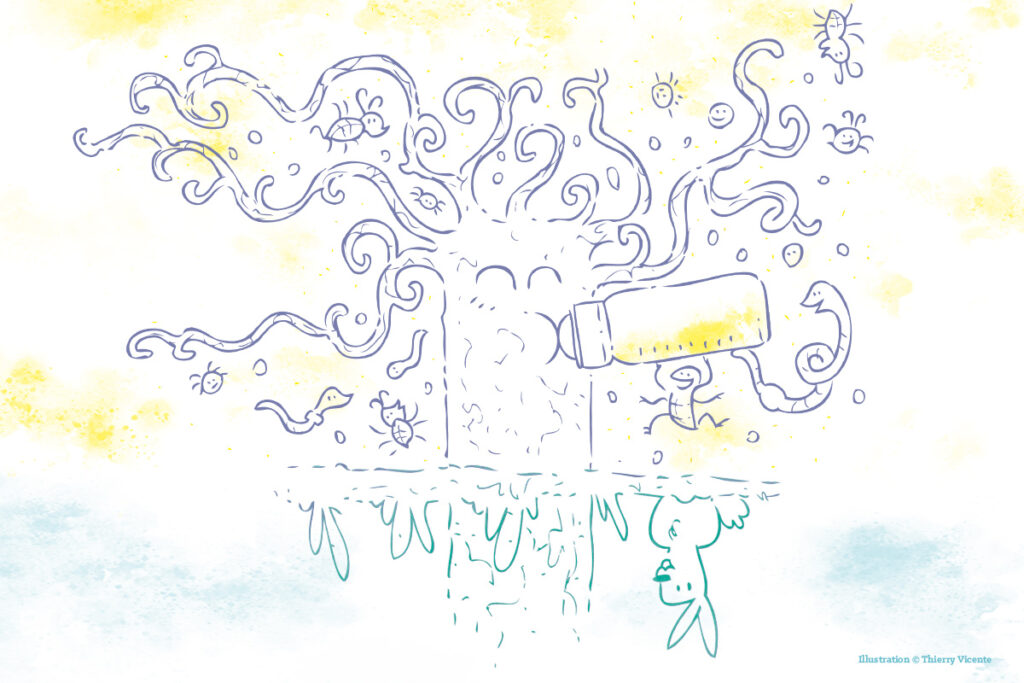[LUM#7] Major soils
Preserving Mother Earth: that's the challenge facing agriculture today. To meet this challenge, scientists are turning their attention to the cradle of crops, the soil. An ecosystem of unsuspected complexity...

It' s impossible to understand soil if we separate it from its context," warns Robin Duponnois, soil microbiologist and Chairman of the French Scientific Committee on Desertification. Only a global approach will enable us to understand these highly complex phenomena ".
Vital symbioses
Here's a quick overview of the complexity involved: without the plant cover that provides the basic material for the underground life cycle - dead leaves and other plant debris - but also without the innumerable hidden underground people, insects, microscopic fungi and other symbiotic bacteria, the only ones capable of transforming this material(see box), there's no salvation for the plant.
Because this one doesn't live on sunshine and fresh water alone. And it is anything but self-sufficient. On its own, it can only access the nutrients closest to its roots. This is not enough to ensure its growth... Fortunately, mycorrhizal fungi can help.1 colonize these same roots with their "hyphae", fine filaments capable of exploring a large volume of soil - giving access to infinitely more nutritive resources(Les associations mycorhiziennes dans les sols, pour une meilleure maîtrise de la production végétale, in Les sols et la vie souterraine, 2017).
More surprisingly, these same fungi play the role of feeders: " complex organic or mineral molecules are found in the soil, which cannot be directly assimilated. The fungus will 'digest' these large molecules, then use its hyphae to transfer the recycled nutrients to the plant ". In exchange, the fungus receives carbon from the plant, which is in a much better position than the fungus to extract it from the atmosphere. Plants thus form inextricable interconnected networks with their fungal buddies. And they can only thrive thanks to this symbiosis... unless they compensate for its absence with artificial mineral fertilizers.
From the "green revolution" to agroecology
Fertilizers, it's true, capable of boosting plants very easily: basically, you introduce a soluble mineral into the soil... and it grows. This is the age-old idea of the " green revolution ": cultivate varieties selected for their optimal production capacity, with the help of fertilizers, pesticides, irrigation and machinery, while favoring large-scale monovarietal cultivation.
What was the impact on the soil and the environment? At the time, we didn't ask ourselves this question. We're in the 60s, just after the great famines. The objective was clear: produce, in quantity. A revolution that was green in name only; costly in water, chemicals and oil, this industrial agriculture had serious drawbacks, foremost among which was the depletion of biodiversity, a major pillar of food security.
Imitating nature
Times have changed: scientists are now calling for an agriculture that can simultaneously feed people and respect the environment. The first law of this "agroecology": " intervene as little as possible! And apply natural biological processes - those at work in a forest. For example, reintroduce vegetation cover by replanting trees; encourage the action of soil microflora (mycorrhizal fungi, nitrogen-fixing bacteria, etc.); or make the most of plants' symbiotic capacities "(Restoring production in tropical and Mediterranean soils. Contribution de l'agroécologie, IRD publication, 2017)
An approach as humble as it is pragmatic. " We try to observe traditional practices that are well adapted to local realities, to help optimize them. Family farming has many virtuous characteristics: small areas, endemic species and poly-specific crops, local know-how and low irrigation levels... If we want to ensure food security in developing countries, it clearly offers a model for the future ", explains Robin Duponnois.
Underground oases
" In just one teaspoon of soil from your garden, there can be several million living organisms," reveals Tiphaine Chevallier of the Eco & Sols laboratory. Soils are made up of clay, silt and sand. But that's not all: it also contains water, air and... life! Although mineral matter predominates, organic matter is also part of the composition of this living cocktail vulgarly known as soil. Organic matter is recycled for plants by countless subterranean inhabitants (microorganisms, but also microfauna: protozoa, tardigrades or mites, macrofauna: woodlice, earthworms, iules...). These organisms ensure that the soil functions properly and produces vital nutrients for plants: nitrogen, phosphorus and potassium. Today, these oases of life are under threat: every year, ten million hectares of arable land are lost worldwide to desertification. This threat directly affects the lives of 480 million people.
- A mycorrhiza is the result of a symbiotic association between fungi and plant roots. ︎
UM podcasts are now available on your favorite platforms (Spotify, Deezer, Apple podcasts, Amazon Music...).